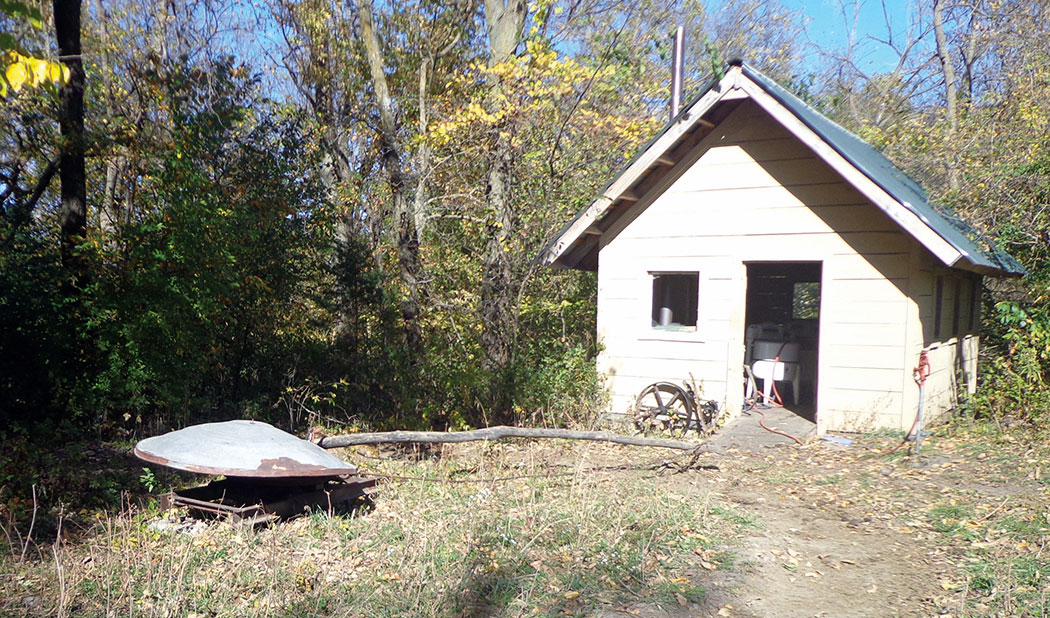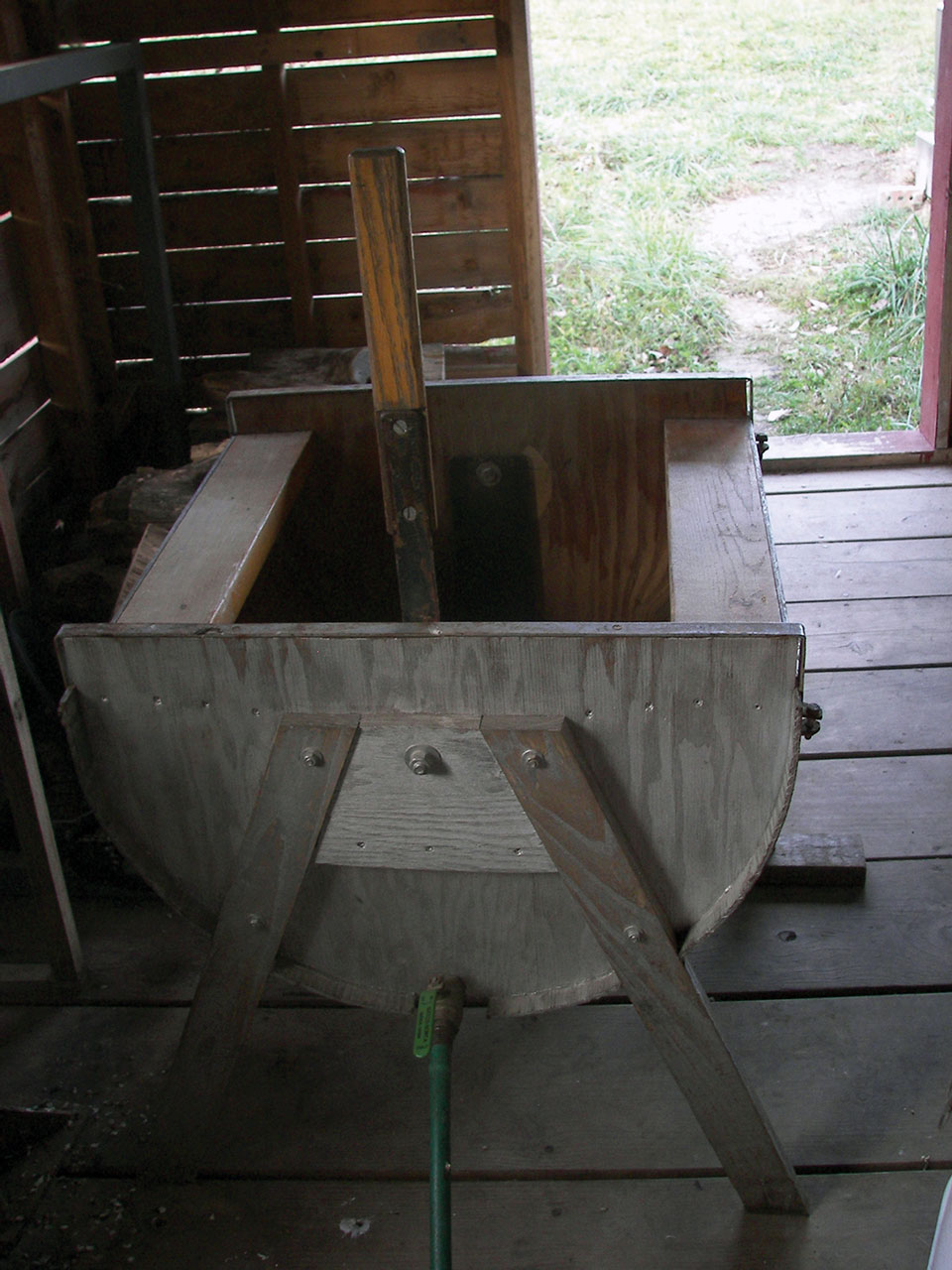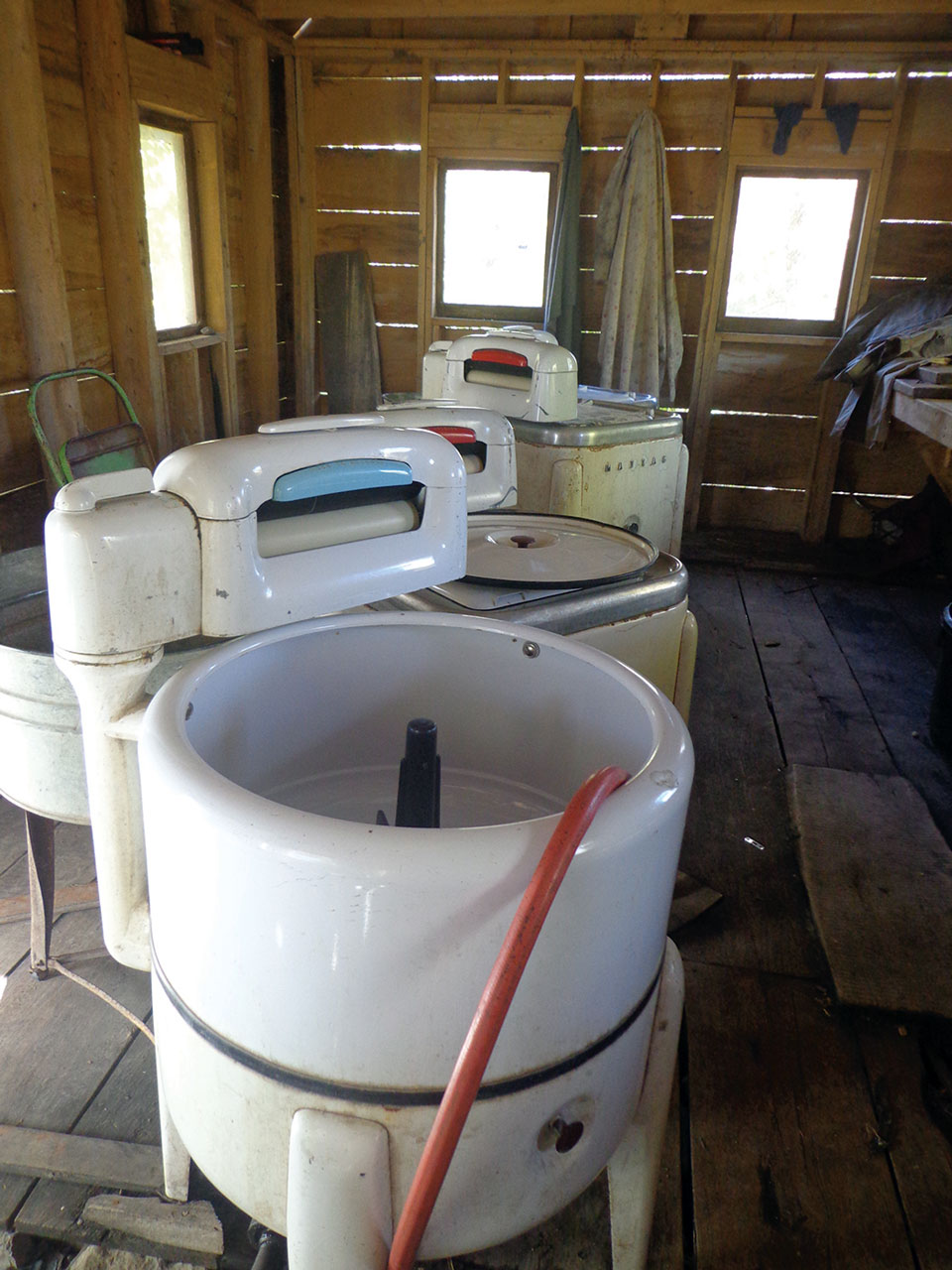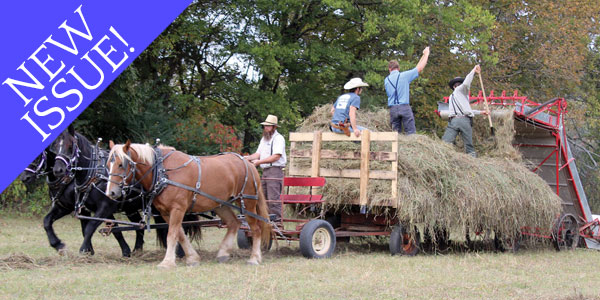
Doing Laundry Without Electricity

Doing Laundry Without Electricity
by Ida Livingston of Davis City, IA
Laundry is one of those jobs that has been around since the dawn of time. The dawn of clothes at least. Electricity has taken a relatively labor intensive job and made it quite easy. All we need now is an automatic clothes folder. But when the power goes out and you are out of socks or you do something like me, crusade into off grid living, you need some alternatives.
There are a variety of options, from washing socks in the sink to buying some sort of non-electric washer. You actually can do laundry a host of different ways. It really depends on you and the resources you have available. I’ll start with the most basic and move on from there.
Basic hand washed laundry works well for small loads of lightly soiled articles of clothing. I like to have three bowls or tubs of water, one for presoak, one for washing and one for rinsing the soap from your clothes. Your soak and wash tubs will both have soap. Your rinse will simply have cool clean water unless you use fabric softener which would go in this tub. Put a reasonable amount of clothing in your soak tub, don’t overfill. Stir lightly and leave it set for about 15 minutes. Agitate the clothes briefly in the soak water and then wring them out and place them in the wash water. Refill your soak water with more laundry.
The laundry now in the wash water can be rubbed against itself, or you can use a scrub brush to gently scrub it clean. Don’t get too carried away, you really can scrub holes in the fabric. Ask me how I know. Swish the article in your water and hold it up to examine, if you are satisfied how clean it is then wring it out and place it in your rinse water. Refill the wash water with more from the soaking laundry.
The rinse is very straight forward. Simply agitate the clothes in your water briefly and wring them out. Hang them up to dry. If you need to dry them extra quickly or you don’t want the clothes to drip in your house, wring it as well as you can and then lay it out evenly over a towel. Roll up your towel and then wring it tightly. Remove your article from the towel and shake it a little to loosen the wrinkles. In a pinch you can even dry socks in a warm oven.
Change your water as it gets dirty. I wash my cleanest laundry first and follow it with more heavily soiled articles later. I usually reuse my wash water at least once or twice. Sometime I will use the last load to prewash an article that I will change my water for and wash it again the next time around.
Now that we have the very basics down let’s talk about other tools and methods. Note: a scrub brush can be your companion through any of these methods. It is very useful for spot cleaning and my husband’s pants need all the help they can get.
When my brother came to be of age and decided he was old enough to make his own decisions, he and my father had the inevitable straight talk. Dad said, “My house, my rule, if you don’t like my rules find your own roof.” So he did. And like many things in life that have unforeseen consequences, he was not as prepared for it as he thought. It was easy enough to find his own house, but he had never cooked a meal or done any laundry or any number of other domestic duties. So he lost 50 pounds that summer and looked fantastic. He learned to operate the machines at the laundromat. But that gets expensive. So he chose something different. He’d put a pair of jeans in a 5 gallon bucket with adequate soap and water. Then he’d pop the lid on nice and tight and rock it back and forth to agitate it for about 10 minutes. Then of course wring it and rinse it and then hang it up. Repeat. Not the easiest way to do laundry, but free.
There are other ways of washing these heavier items, or items in general, that I prefer. I do have, and use on occasion, a washboard. Mine has the typical wood frame but has glass ribbing to rub your clothes against. I got mine years ago from the Columbus Washboard Company. They make and sell American made washboards with metal or glass ribbing. Excellent quality.
With a washboard you use the same basic method as already described; you are rubbing the soiled parts of the clothing over the ribbing on the washboard for the agitation required to separate the dirt from your clothing. If you do not have a washboard, don’t let that hold you back. You can improvise, a length of rough cut lumber can be used as a washboard.
For centuries laundry has been done by using this principle – rubbing the laundry clean on a relatively large stone down by the creek. As far as that goes it would be a great exercise to try on a camping trip. For better or for worse it would certainly make some memories the kids won’t forget. Dip out a bucket of water and bring it away from the creek to wash the laundry. Don’t put the detergent back in the flowing water, our waterways have enough pollution to deal with as it is. Wash your laundry out of a bucket, rubbing the soiled areas on a stone as you go, dipping it back in the bucket repeatedly. Wring them out and lay aside. Pour out your water several yards away from the creek. Dip out some more water to rinse the clothes out in. When you hang the clothes up just drape them over some open limbs in a tree or on some nice clean grass or bushes.
Another popular hand washed laundry method involves a plunger. Prepare your laundry in a bucket or a tub with soap and water in the process already described. Then take the plunger and plunge the items vigorously until you are tired of it. Then inspect each article and spot clean with a scrub brush where you missed. Continue with wringing and rinsing as any other method. Don’t have a plunger? Don’t let that hold you back. Load your tub or bucket anyway, being careful not to overfill it. Now take off your shoes, roll up your pants and stomp the laundry to provide the needed agitation. Inspect it now and again until you are satisfied it is clean enough.

Now beginning to move away from hand washing and closer to machine washing, let me introduce you to a James washer. It likely has other names that it goes by, but this is what I have always heard it called. Basically it is a tub on legs with a manual agitator activated by a handle you rock back and forth. The handle swings a bar inside the tub to the contour of the tub sloshing the laundry from one side to the other.
When you use a James washer you use the same basic setup. A tub for soak, your wash water goes into the James and you have another tub for your rinse. To use the washer you push or rock the handle from one side to the other, counting as you go. I count pushing the handle from the left to the right and then back to the left as one. On my average load counting this way I would count to 300. I may only count to 100 on a lightly soiled load such as sheets. On a heavily soiled load I may count as high as 450 or more. Ladies and gentlemen, this builds muscle, I kid you not. Do not arm wrestle the washer woman.
There are a number of places that sell these. Often you will see them made of stainless steel, a great idea, but I honestly don’t recommend those. I have had one, and my present James washer has a wooden tub. It is far superior. Why? When you use a metal James washer and you have a metal button turn sideways, or forget those nails in your pocket, it can gouge your machine. These gouges in a metal tub create sharp edges which can cut or tear your clothing as you wash them. A wooden tub may gouge as well but does not leave the sharp edges that cut fabric. A wooden tub James washer can easily last 20 years or more if it is well taken care of. I bought mine from an Amish man in Kentucky who makes them. He charges $400 for the machine, $11 for handling, and $59 for shipping (USA), coming to a total of $470. Obviously the shipping and costs are subject to change. Write James Habegger, 1960 Shores Road, Scottsville, KY 42164.

Now on to the wringer washers. Most wringer washers are motor driven. This will appeal to many, unless like me you don’t even remotely have a mechanical brain. I found this out when I took a small engine class in high school. We had to take apart an engine that worked, all the way apart mind you, and then put it back together. Yeah, mine was the only one that wouldn’t start again.
Anyway, you can get these wringer washers and have them belt driven off of a small gasoline motor. Some of these washers come with their own motor powered by an electric cord. This motor can be removed and the machine converted to a gas motor.

Our wringer washer was converted to run off of horse power. Yes, I said horse power. There are times when “living simply” is anything but simple. A horse power unit is that. We use one to run the laundry house. An oversimplified description of the process is this: a horse walks in a circle on a path called a track, the horse pulls a sideways tongue that activates a set of gears (the horse power unit) that turn a power shaft, attached to which are pulleys that have belts connecting them to the machines. This requires a building, a horse power unit, shafts, pulleys and belts, along with the horse. In my mind this doesn’t equate to “simple,” but according to my husband, a horse power unit is actually a very simple engine. Large, yes, but simple.
Your wringer washer has the same basic setup. Soak, wash, rinse. The agitator is the same as your regular top loading electric washer. The washer comes with a wringer, hence its name. The wringer has a handle that controls the rollers which are very effective at pressing the water out of your clothes so they dry faster when you hang them up. The wringer is famous for catching fingers and pulling your hand in. For this reason there is a safety release button you can hit that immediately releases the rollers. If this fails simply turn the handle to unroll the rollers off your hand. It is no understatement to say this is very painful, but I have never known anyone to get anything more than some very lively bruises from it. You’ll never forget to keep track of your fingers again.
There are days when my husband is using the horses for other things, or I am not doing enough laundry to justify going for the horse. Or it is very rainy and using the horsepower when it is muddy will turn the track to soup. Times like this I skip the wringer washer and use my trusty James. If we are hit by an Arctic blast in the winter I will hand wash enough in the house to get by.
To some people, having a wringer is important to aid fast drying time. Really though, you can hang up your clothes on a line without wringing them at all and they will still dry. Gravity will pull most of the drips out overnight and then any decent weather will dry them the next day.
Clothes lines are wonderful things. There have been times where I felt I needed miles of them. My favorite is the simple clothes line frame with wire lines. I have also used those snazzy looking lines attached to pulleys, the other end being well off the ground. Ours was on a small hill on one end and 30 ft up at the top of a tree at the other end. Gets a lot of air to dry quickly up there. Which is part of its downside too. The driest clothes are the farthest away from me. And if I really need that shirt I hung up first then I have to take off all the clothes I hung up since then to get to it. Taking off all those wet clothes just to get to that one thing has been done. I just have to take a few deep breaths to collect myself and then do it.
Short on clothes line? I’ve been there before. I have run lines from one tree to the next to make extra lines. I have also draped clothes over the cedar split rail fence in front of my house. In a pinch there is always the tines on the antlers of my brother in law’s mounted deer… (Just joking!)
As long as there are clothes there will be laundry to be done. But no matter where you are you can feel confident that you can meet your own needs. Even hand soap in a bathroom sink will wash clothes. Wherever you are, look around you and be resourceful. Know what you can do, but don’t limit yourself to only what you know. Use your present skills to build more. Being flexible and adaptive is a form of freedom. Freedom from fear, freedom from anxiety. Your independence is in your hands.




